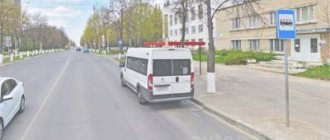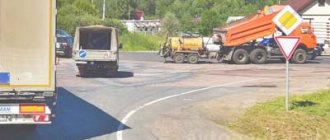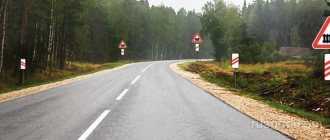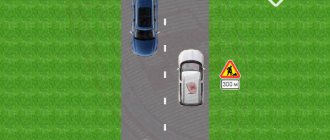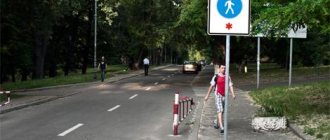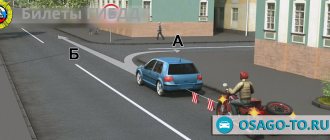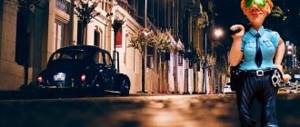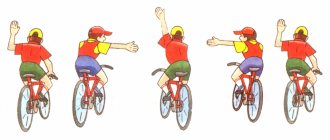Purpose
The purpose of these signs is quite varied and it is very difficult to define them unambiguously. There is even an opinion that this group includes signs that were not included in other groups.
However, there is a definition and it is formulated in the traffic rules:
Signs of special requirements are intended to introduce or cancel certain traffic modes.
They introduce or cancel restrictions, inform the driver about driving modes and can combine several instructions at once.
Requirements for size, shape, installation
The standard size and rules for installing indicators of special requirements are subject to the requirements approved by GOST.
They are made in rectangular or square shapes.
Their main color scheme is white and blue with white markings.
on a blue background or, conversely, blue on a white background.
Additional colors may be used to inform drivers and pedestrians:
red;
yellow;
black;
The signs are installed directly above the lane to which the regulations indicated on the panel apply. If a sign is placed to the right of the road in the direction of travel, then the information it carries concerns exclusively the right lane, unless it is a sign that relates to several lanes at once, which will be depicted directly on it.
A mark informing about traffic in lanes can be installed each above “its own” lane or on one common board near the road. The important thing is that their effect extends entirely to the intersection, and not to the first intersection of roads.
Often, so that drivers can figure out in advance which lane in which direction they can drive, where to turn around and have time to change lanes, signs are installed both on the banner above and near the road, plus they are duplicated with markings on the road surface.
Detailed description with explanations
Tells the driver to start driving on the highway. By default, passenger cars are allowed to travel at a speed of no more than 110 km/h. In order to ensure such a high speed, certain design solutions are used on highways:
- The presence of a dividing strip, which practically eliminates head-on collisions of oncoming vehicles.
- There are no intersections at the same level with roads, railways and tram tracks, as well as the absence of surface pedestrian crossings.
A number of restrictions are also introduced:
By the way, a highway is a sign with a green background, and if you see a green background on other road signs, for example, on information ones (such as the name of an object, an indicator of distances and directions), then the road to these objects will pass along the highway.
Sign 5.2 informs the driver about the end of the highway, which means a reduction in the speed limit and the abolition of the restrictions described above.
Designed only for the movement of cars, buses and motorcycles.
The presence of a dividing strip is not regulated here, so the maximum speed is limited to 90 km/h. But all other prohibitions and restrictions are exactly the same as when driving on highways.
5.4 warns of the end of the road for cars.
The movement of all vehicles along the entire width of the roadway is carried out in one direction. I would like to draw your attention to the fact that stopping and parking on such roads for passenger cars and trucks with a maximum permitted weight of up to 3.5 tons is permitted on both the left and right sides of the road. Reversing is also not prohibited. 5.6 speaks of the end of the road, where one-way traffic is organized.
Installed before exiting or crossing a one-way road. The direction of the arrow on the sign corresponds to the direction of traffic flow. In fact, the signs prohibit turning in the direction opposite to the arrow. But under no circumstances is it prohibited to turn around.
The beginning and end of a road with reverse traffic. Tells the driver that the direction of movement in one or more lanes, depending on the situation (time of day, day of the week, etc.) may change to the opposite.
Reversible lanes are indicated by a double broken line marking. And it is prohibited to drive onto them without seeing a reverse traffic light signal.
Drive out onto a road where reverse traffic is organized. The principle is the same as what I described earlier: without seeing a reversible traffic light signal, you cannot turn into reversible lanes (marked by markings).
The beginning and end of the road, with a dedicated lane for route vehicles moving towards the general traffic flow. Entering this lane is strictly prohibited and is equivalent to entering oncoming traffic.
The beginning and end of the road, with a dedicated lane for cyclists and moped riders who are moving towards the general traffic flow.
It is installed before entering the road, where there is a lane for route vehicles moving towards the main traffic flow. Turning into this lane, as well as driving along it, is prohibited. Turning around at such intersections is not prohibited!
Informs the driver about an intersection with a road where there is a dedicated lane for bicycles and mopeds. Like the previous sign, it is prohibited to turn into this lane.
Tells the driver about the beginning/end of the lane for route vehicles. Moreover, in this case, the lane is favorable. If the sign is supplemented with a “traffic lane” sign, then the lane to which the arrow points is allocated for route vehicles. If there is no such sign, then no matter where the sign is installed (on the left or right of the road, above the road), the lane for route vehicles is the far right.
Now is the time to decide whether you can occupy it?
There are two scenarios here:
- this lane is separated from the rest of the roadway by a continuous marking line. In this case, under no circumstances can you drive onto it;
- the strip is separated by a broken marking line. Traffic on it is prohibited. But before turning left, we must first change lanes to it (using it as a braking area), and when entering a road with a lane for route vehicles, first take this lane, using it as an acceleration lane. Beginning/end of the lane for bicycles and mopeds. Other t.s. they cannot use it.
The situation is similar with the lane for cyclists and moped drivers; other vehicles cannot occupy it.
Indicates the number of lanes and the permitted directions of movement along them. Can be installed both above the roadway and to the left/right of it. Only route vehicles can deviate from the requirements.
Indicates possible driving directions for each lane. Unlike previous signs, signs in this series are installed above each lane. They are placed in advance so that the driver can take the position necessary for a particular maneuver in advance.
Informs the driver about the presence of an additional passing lane for traffic, and indicates which side it will appear on. On the sign you can find additional instructions, for example: restrictions for certain categories of vehicles. or minimum speed limit.
Notifies the driver about the end of the lane and the need to change lanes soon.
Shows the driver the number of lanes on the roadway and the restrictions that apply to each of them.
Not only a bus stop, but also a trolleybus stop. Stopping and parking closer than 15 meters is prohibited. If there is a marking, then we take the distance from the yellow zigzag line, if there is no marking, then from this sign. An exception is stopping to pick up/drop off passengers, but the driver must not interfere with buses and trolleybuses. And also give way to route vehicles leaving the stopping place.
Tram stop location. Very often the tram stops in the middle of the roadway and the paths of pedestrians walking towards the tram and cars intersect. In this case, pedestrians, or passengers, who are on the side of the tram doors, have priority over cars, that is, the driver must let them through.
This is how taxi parking areas are designated.
Regardless of whether there is a zebra marking or not, this sign indicates a pedestrian crossing. The boundaries of a pedestrian crossing are considered to be the distance between two such signs installed on different sides of the road.
Indicates the front (closest to the driver) boundary of the artificial hump. When this sign is detected, the driver is advised to reduce speed in advance.
The beginning and end of the residential area. Here pedestrians have priority over cars over the entire width of the roadway. Certain restrictions are introduced in the area of the sign:
- through traffic ban
- training ride
- parking with engine running
- permitted speed no more than 20 km/h
- parking of trucks (with a permissible weight of more than 3.5 tons) outside specially designated areas
A sign on a white background means that the driver is entering a populated area. And accordingly, all rules for movement within the boundaries of a populated area come into force:
- speed limit 60 km/h
- restriction on sound signal (except for accident prevention), etc.
This sign informs the driver about the presence of a populated area, but since it is located somewhat to the side and the driver does not pass through it, the rules for driving in a populated area do not apply here.
Signs of special regulations
Traffic regulations 2021, 2021 with online comments
Appendix 1 Traffic rules Road signs (according to GOST R 52289-2019 and GOST R 52290-2004)
Special regulations signs introduce or cancel certain traffic modes.
About what the signs of this group mean and what they are used for can be found in the introductory article Road signs with special requirements.
| 5.1 "Highway". A road on which the requirements of the Road Traffic Rules of the Russian Federation apply, establishing the procedure for driving on highways. |
| 5.2 "End of the motorway." |
More information about the Highway road sign, as well as restrictions on movement and maneuvers on roads marked with this sign, can be found in the article Signs of special requirements 5.1 - 5.4.
| 5.3 “Road for cars.” A road intended for use only by cars, buses and motorcycles. |
| 5.4 “The end of the road for cars.” |
More information about the road sign Road for cars, as well as restrictions on movement and maneuvers on roads marked with this sign, can be found in the article Signs of special requirements 5.1 - 5.4.
| 5.5 “One-way road.” A road or carriageway along which vehicle traffic across its entire width is carried out in one direction. |
| 5.6 "The end of a one-way road." |
U-turns are prohibited on one-way roads. Reversing is not prohibited. But before you drive in reverse on a one-way road, it makes sense to first make sure that you are not in a place on the road where reversing is not allowed by traffic regulations. Reversing is prohibited on roads marked with signs 5.1 or 5.3, as well as in places specified in paragraphs 8.12 and 8.11 of the traffic rules.
On one-way roads in populated areas, passenger cars are allowed to stop and park on both the right and left sides of the road, unless this is prohibited by the relevant road signs and markings (clause 12.1 of the traffic rules).
More information about road signs 5.5 and 5.6 can be found in the article Signs of special requirements 5.5 - 5.10.
| 5.7.1, 5.7.2 “Entering a one-way road.” Entering a one-way road or carriageway. |
These signs inform you that you are entering a one-way road and prohibit you from turning towards one-way traffic. If such a sign is posted before a four-way intersection, you have the right to turn in the direction of the arrow on the sign, continue straight ahead, or turn around.
When turning right at an intersection in front of which there is sign 5.7.1, you should move as close as possible to the right edge of the roadway (Section 9.4 of the Traffic Rules). After turning, the entire roadway is allowed to be used for traffic.
For more information about the road signs “Exiting onto a one-way road”, see the article Signs of special requirements 5.5 - 5.10.
| 5.8 "Reverse movement". The beginning of a section of road where one or more lanes may change direction to the opposite direction. |
| 5.9 “End of reverse movement.” |
| 5.10 “Entering a road with reverse traffic.” |
When turning onto a road with reverse traffic, the vehicle must be driven in such a way that when leaving the intersection of roadways, the vehicle occupies the far right lane. Changing lanes is permitted only after you are convinced that traffic in this direction is also permitted in other lanes except the right one (Section 9.8 of the Traffic Regulations).
For more information about road signs indicating reverse traffic, see the article Signs of special requirements 5.5 - 5.10.
| 5.11.1 “Road with a lane for route vehicles.” A road on which vehicles allowed to move in lanes for route vehicles move along a specially designated lane towards the general flow of vehicles. |
A limited number of vehicles have the right to move in the dedicated lane for route vehicles (see sign 5.14). The designated lane in these circumstances is the oncoming lane! Accordingly, you may receive sanctions for entering this lane. More information about the sign “Road with a lane for route vehicles”, as well as about fines for a dedicated lane, can be found in the article Signs of special requirements 5.11.1 - 5.14.3.
| 5.11.2 “Road with a lane for cyclists.” A road on which the movement of cyclists and moped drivers is carried out in a specially designated lane towards the general flow of vehicles. |
In this case, the dedicated lane for bicycles and mopeds is a counter lane! Entry of other vehicles is prohibited. For more details, see the article Signs of special requirements 5.11.1 - 5.14.3.
| 5.12.1 “End of the road with a lane for route vehicles.” |
| 5.12.2 “End of the road with a lane for cyclists.” The road sign is a road sign 5.11.2, the image of which is crossed out by a diagonal red stripe from the lower left corner to the upper right corner of the sign. |
When following the road marked with signs 5.11.1 and 5.11.2, you must understand that you are moving on a roadway on which one-way traffic rules apply (moving forward only, turning around is prohibited).
| 5.13.1, 5.13.2 “Entering a road with a lane for route vehicles.” |
Signs 5.13.1, 5.13.2 inform that the road being crossed has a dedicated lane for route vehicles. For all vehicles that are prohibited from moving on a dedicated lane, sign 5.13.1 prohibits turning left, sign 5.13.2 prohibits turning right. For more details, see the article Signs of special requirements 5.11.1 - 5.14.3.
| 5.13.3, 5.13.4 “Entering a road with a lane for cyclists.” |
Signs 5.13.3, 5.13.4 inform that the road being crossed has a dedicated lane for bicycles. If your vehicle is NOT a bicycle or a moped, sign 5.13.3 requires you to turn right, and sign 5.13.4 requires you to turn left. For more details, see the article Signs of special requirements 5.11.1 - 5.14.3.
| 5.14 “Lane for route vehicles.” A specially designated lane along which vehicles allowed to move in lanes for route vehicles move in the same direction as the general flow of vehicles. |
The dedicated lane, marked 5.14, is a passing lane. Entry to this lane is permitted in accordance with paragraph 18.2. The same paragraph defines the list of vehicles that are allowed to drive in the dedicated lane:
- Route vehicles (buses, trolleybuses, minibuses);
- School buses;
- Vehicles used as passenger taxis;
- Buses heavier than 5 tons, which are included in the lists approved by the executive authorities of Moscow, St. Petersburg and Sevastopol;
- Cyclists.
The listed vehicles are not always allowed to enter the dedicated lane, but only when the entry itself does not contradict the traffic rules. For more details, see the article Signs of special requirements 5.11.1 - 5.14.3.
| 5.14.1 “End of lane for route vehicles.” |
Sign 5.14.1 means that the allocated lane for route vehicles has ended.
| 5.14.2 "Lane for cyclists". |
A lane of road on which bicycles and mopeds are allowed. For more details, see the article Signs of special requirements 5.11.1 - 5.14.3.
| 5.14.3 “End of lane for cyclists.” |
The effect of signs 5.14 - 5.14.3 extends to the lane above which they are located. The effect of signs installed on the right of the road extends to the right lane.
The lane for route vehicles may display road markings in the form of the letter “A” (horizontal markings 1.23.1). If this lane is separated from the rest of the roadway by a continuous marking line, then other vehicles are prohibited from entering it.
If the lane is separated by intermittent markings, then before leaving the road for a right turn, the driver must first change lanes to it. It is allowed to enter the dedicated lane when entering a road with a right turn, as well as for boarding and disembarking passengers, provided that the lane is separated by intermittent markings and does not create interference for route vehicles.
| 5.15.1 “Traffic directions along lanes.” The number of lanes and permitted directions of movement for each of them. |
| 5.15.2 “Lane directions”. Permitted lane directions. |
Signs 5.15.1 and 5.15.2, which permit a left turn from the extreme left lane, also permit a U-turn from this lane.
Signs 5.15.1 and 5.15.2 do not apply to route vehicles.
The effect of signs 5.15.1 and 5.15.2 installed in front of the intersection applies to the entire intersection, unless other signs 5.15.1 and 5.15.2 installed on it give other instructions.
The only difference between signs 5.15.1 and 5.15.2 is that the first signs look combined, and the second ones look separate, for each of the lanes. The function of these signs is the same. For more details, see the article Signs for lane directions.
| 5.15.3 "Start of strip" . The beginning of an additional uphill or braking lane. |
If the sign installed in front of the additional lane displays sign(s) 4.6 “Minimum speed limit,” then the driver of a vehicle who cannot continue driving along the main lane at the indicated or higher speed must change lanes to the lane located to his right.
This organization is done with the aim of increasing the capacity of this section of the road, since cars should move faster in the left lanes. For more details, see the article “Start of Lane” and “End of Lane” signs.
| 5.15.4 “Start of stripe”. The beginning of the middle section of a three-lane road intended for traffic in a given direction. If sign 5.15.4 shows a sign prohibiting the movement of any vehicles, then the movement of these vehicles in the corresponding lane is prohibited. |
Lane Start signs are also used before intersections to designate additional turn-only lanes. Such strips are often used for other purposes, for which sanctions are provided. For more details, see the article “Start of Lane” and “End of Lane” signs.
| 5.15.5 “End of lane”. The end of an additional uphill lane or acceleration lane. |
A sign warns that the roadway narrows on the right. You will need to change lanes to the left. How best to act when you are moving along a lane and see the “End of Lane” sign - in the article “Start of Lane” and “End of Lane” Signs.
| 5.15.6 “End of lane”. The end of a section of the median on a three-lane road intended for traffic in a given direction. |
A sign warns that the roadway narrows on the left. You will need to change lanes to the right, into the adjacent lane. How best to act when you are moving along a lane and see the “End of Lane” sign - in the article “Start of Lane” and “End of Lane” Signs.
| 5.15.7 “Direction of traffic along the lanes.” |
If sign 5.15.7 shows a sign prohibiting the movement of any vehicles, then the movement of these vehicles in the corresponding lane is prohibited.
Signs 5.15.7 with the appropriate number of arrows can be used on roads with four or more lanes.
Signs 5.15.7 are used on roads where the number of lanes in a given direction is greater than in the oncoming direction. More information about these signs can be found in the article Signs for lane directions.
| 5.15.8 “Number of lanes”. Indicates the number of lanes and lane modes. The driver is obliged to comply with the requirements of the signs marked on the arrows. |
Signs 5.15.8 are installed in front of sections of roads on which a special lane driving regime is introduced. Driving modes, such as speed limits, are indicated on signs 5.15.8, and will later be duplicated with sign 8.14 “Traffic Lane” above each relevant lane. For more details, see the article Signs for lane directions.
| 5.16 “Bus and (or) trolleybus stopping place.” |
| 5.17 “Tram stopping place.” |
| 5.18 “Taxi parking area.” |
Signs 5.16, 5.17 and 5.18 are used to designate stopping points for the corresponding types of route vehicles and parking for passenger taxis. It should be remembered that stopping or parking is prohibited closer than 15 meters from the stops of route vehicles or the parking of passenger taxis (clause 12.4 of the traffic rules).
For more details, see the article Signs of special regulations 5.16 - 5.22.
| 5.19.1, 5.19.2 “Pedestrian crossing”. |
If there are no markings 1.14.1 or 1.14.2 , sign 5.19.1 is installed to the right of the road on the near border of the crossing relative to approaching vehicles, and sign 5.19.2 is installed to the left of the road on the far border of the crossing.
Turning, stopping and parking of vehicles is prohibited at pedestrian crossings. Stopping and parking of vehicles is also prohibited within 5 meters of a pedestrian crossing. For more details, see the article Signs of special regulations 5.16 - 5.22.
| 5.20 “Artificial hump”. Indicates the boundaries of an artificial roughness. The sign is installed at the nearest boundary of the artificial hump relative to approaching vehicles. |
For more information about the “Artificial Roughness” sign, see the article Signs of special requirements 5.16 - 5.22.
| 5.21 “Residential area”. The territory in which the requirements of the Road Traffic Rules of the Russian Federation are in force, establishing the rules of traffic in a residential area. |
| 5.22 “End of the residential area.” |
More information about the “Residential zone” sign can be found in the article Signs of special requirements 5.16 - 5.22. Rules for driving in areas marked with these signs are in the article Traffic in courtyards and residential areas.
| 5.23.1, 5.23.2 “Beginning of a populated area.” The beginning of a populated area in which the requirements of the Road Traffic Rules of the Russian Federation are in force, establishing the procedure for traffic in populated areas. |
| 5.24.1, 5.24.2 “End of a populated area.” The place from which on a given road the requirements of the Road Traffic Rules of the Russian Federation, establishing the procedure for traffic in populated areas, cease to apply. |
More information about the signs indicating the beginning and end of a populated area, made on a white background, as well as about traffic conditions in a populated area, can be found in the article of the same name: Signs Beginning and End of a populated area.
| 5.25 “The beginning of a settlement.” The beginning of a populated area in which the requirements of the Road Traffic Rules of the Russian Federation, which establish traffic rules in populated areas, do not apply on this road. |
| 5.26 “End of a settlement.” The end of the settlement indicated by sign 5.25. |
More information about the signs indicating the beginning and end of a settlement, made on a blue background, can be found in the article of the same name: Signs Beginning and End of a settlement.
| 5.27 “Zone with limited parking.” The place from which the territory (section of the road) begins where parking is prohibited. |
| 5.28 “End of restricted parking zone.” |
More information about signs 5.27 and 5.28 can be found in the article Signs of special regulations 5.27 - 5.32.
| 5.29 “Regulated parking zone.” The place from which the territory (section of the road) begins, where parking is permitted and regulated with the help of signs and markings. |
| 5.30 “End of regulated parking zone.” |
For more information about signs 5.29 and 5.30, see the article Signs of special regulations 5.27 - 5.32.
| 5.31 “Zone with maximum speed limit.” The place from which the territory (section of the road) begins where the maximum speed is limited. |
| 5.32 “End of zone with maximum speed limit.” |
For more information about signs 5.31 and 5.32, see the article Signs of special requirements 5.27 - 5.32.
The effect of signs 5.27, 5.29 5.31 applies to both sides of the road, this is their difference from signs 3.28 “Parking prohibited”, 6.4 “Parking (parking space)” and 3.24 “Maximum speed limit”.
Information about the types of vehicles that are subject to the corresponding restriction, about the duration of validity, about the method of parking the vehicle, its duration, etc. placed on signs under signs or at the bottom of signs 5.27, 5.29, 5.31.
| 5.33 “Pedestrian zone”. The place from which the territory (section of the road) begins where the movement of pedestrians and, in the cases established by paragraphs 24.2 - 24.4 of these Rules, cyclists is permitted. |
More information about the Pedestrian Zone sign, as well as fines for violating traffic rules in the territory designated by this sign, can be found in the article Pedestrian Zone and Bicycle Zone Signs.
| 5.33.1 “Bicycle zone”. The place where the bicycle zone begins. | no official image available |
More information about the Bicycle Zone sign, as well as fines for violating traffic rules in the territory designated by this sign, can be found in the article Pedestrian Zone and Bicycle Zone Signs.
| 5.34 “End of the pedestrian zone.” |
| 5.34.1 “End of the bicycle zone.” | no official image available |
Signs 5.34 and 5.34.1 indicate the places where the territorial zones, indicated by signs 5.33 and 5.33.1, end, respectively.
5.35. "Zone with restrictions on the environmental class of motor vehicles." The place from which the territory (section of the road) begins where the movement of motor vehicles is prohibited:
|
5.36. "Zone with restrictions on the environmental class of trucks." The place from which the territory (road section) begins where the movement of trucks, tractors and self-propelled vehicles is prohibited:
|
Signs 5.35 and 5.36 do not apply to motor vehicles of the Armed Forces of the Russian Federation, police, emergency rescue services and units, fire protection, ambulance, gas network emergency service and motor vehicles of federal postal organizations that have a white mark on the side surface diagonal stripe on a blue background.
The environmental class was included in the traffic rules in the summer of 2021. In this regard, new road signs appeared. More information about signs 5.35 and 5.36 can be found in the article Signs “Zone with environmental class restrictions”.
| 5.37 “End of the zone with restrictions on the environmental class of motor vehicles.” |
| 5.38 “End of the zone with restrictions on the environmental class of trucks.” |
Design features
Signs are made of galvanized metal sheets. A square or rectangle of the required size is cut out. The edges are flanged. This technique makes the sign stronger and more reliable. The shield becomes stronger and holds its shape better, and does not bend under the influence of wind.
A reflective film is applied on top of the metal.
The film material is durable:
- to temperature changes;
- UV irradiation;
- aggressive environmental influences;
- acts of vandalism.
Thanks to the contrasting colors, reflective properties of the film material, and clear informative lines, the sign is clearly visible in any weather and time of day, which is important for the timely delivery of special instructions to the driver and the prevention of emergency situations.
For the same purpose, the “Pedestrian crossing” sign is always made double-sided so that it is clearly visible from all sides by both pedestrians and drivers.
On our website you can order road signs for special requirements by selecting the desired film from the catalog.
Our signs are different:
compliance with GOST standards in all respects;
long term of impeccable service;
quality of workmanship;
affordable prices.

